EARLY TENANTS AND GUESTS AT MOUNT MERRION LODGE
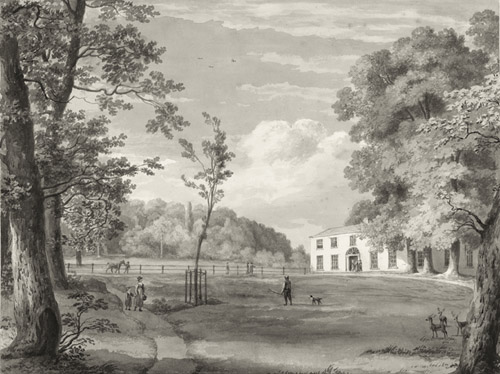
We know that the first wing of Mount Merrion Lodge was built in 1711. During that year the Stable Block and the Farmyard was also built. However, Richard the 5th Viscount Fitzwilliam really wanted to pursue a serious career in politics.
He was a member of the Irish Parliament but in reality the real action was in London. For that reason he was not particularly interested in developing Mount Merrion Lodge and the 300 acre Demesne that surrounded it. The completed wing was spacious enough for his family and servants.
He canvassed hard in London and in 1726 his prayers were answered. He was elected as MP for FOWEY Cornwall to the House of Commons in Westminster. The Family moved to the greater London area and the Viscount never again resided in Mount Merrion.
The Agent was instructed to prepare the Lodge for Rental and to procure distinguished tenants. Now that was not as big a task as it sounds as the Demesne was one of the best situated Houses in Dublin with it’s unrivaled views of Dublin Bay, Ireland’s Eye, Lambay Island, the Dublin and Wicklow Mountains and the City of Dublin.
Over the next century or so the list of Tenants and their guests represented a who’s who of Dublin Society and British Administration in Ireland.
The first tenant was a young newly appointed Judge to the Irish circuit, JOHN WAINWRIGHT. Judge Wainwright quickly gained a reputation of being a very fair and compassionate man and was very popular on the Circuit both in Leinster and in Munster. He took up residence in Mount Merrion in 1732
An early visitor to Mount Merrion as a guest of Judge Wainwright was an old school pal THOMAS PELHAM HOLLES the 1st Duke of Newcastle on Tyne. Holles served in the government of Sir Robert Walpole for more than 20 years as Secretary of State and twice as Prime Minister.
Wainwright had a particular fondness for GEORGE BERKELEY, the Bishop of Cloyne. Berkeley was the leading Philosopher and Author of his time. He was also an early philanthropist who gave freely of his time and money. He is reported to have written a number of his important texts whilst in situ in Mount Merrion.
Indeed there must have been something in the South Dublin air at that time because a number of distinguished Episcopal visitors availed of their time there to compose some of their most significant papers.
Another man of the cloth who frequented the Lodge was ROBERT CLAYTON who although born in Preston Lancashire entered TCD at the tender age of 15 and became a fellow at 20 years of age. Shortly after he married the daughter of Lord Donnellan he was elected Bishop of Killala followed by Cork and finally Clogher.As he aged his writings and homilies became more controversial. In fact at the time of his death in 1758 he was under notice to appear at an ecclesiastical court where a number of serious charges were to be levelled at him.
Sticking with the Clerical visitors ANDREW STONE was a very interesting man. This Oxford graduate came to Ireland as Chaplin to The Duke of Dorset the Lord Lieutenant. Probably the most politically involved clergy man of his era he was Bishop of Ferns, Kildare and Derry before being appointed Archbishop of Armagh and Primate of all Ireland.
The above mentioned Lord Lieutenant LIONAL SACKVILLE the DUKE of DORSET became a very good friend of Wainwright during his two terms in Ireland. His Secretary, also a frequent visitor, was a very interesting character called BUBB DODDINGTON. His real name was actually George Bubb; he adapted the Doddington affix after the death of his uncle. He has been described as a Maecenas (someone who attaches themselves to Noble, Rich or Artistic people). He must have been successful because he had acquired the title Baron Melcombe before he died in 1762.
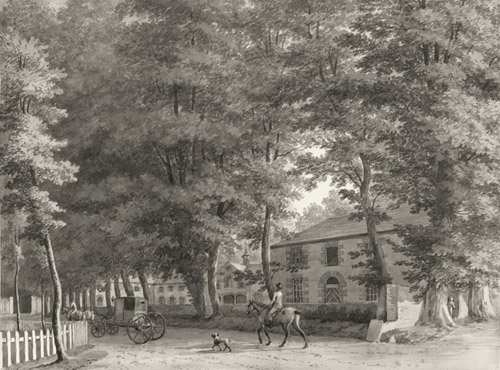
In 1741 John Wainwright contacted a fever whilst serving on the Southern Circuit and died a few days later in Mount Merrion.
John Wainwright was succeeded as tenant in Mount Merrion by Lord Chancellor ROBERT JOCELYN. Jocelyn lived there from 1741 until 1756. He had been resident in Dublin since the 1720s and immediately before his elevation to the office of Lord Chancellor he had been Speaker of the House in the Irish Parliament. So he already had a large circle of friends and acquaintances.
JOHN LODGE. Lodge was the son of a Lancashire farmer and a Cambridge graduate. He came to Ireland as Deputy Keeper of Records In 1754 he compiled the Monumental “The Peerage of Ireland” in 4 Volumes and 1600 pages, it is so important that it has recently been reprinted on CD Rom.
Another popular guest was WALTER HARRIS the son of a Mountmellick Farmer he was expelled from TCD for participating in a riot. They later conferred on him a LLD degree for his services to Irish Historical Research and Archaeology. He is best remembered for his editing and translation of the works of Sir James Ware.
In keeping with the literary theme CHARLES SMITH, a Dungarvan based Doctor often overnighted in the Lodge. He is best remembered as Ireland’s foremost Topographer and writer of numerous County Histories. His “Ancient and Present State of the County of Kerry” has recently been reproduced on CD Rom. His detractors accused him of writing favourable accounts of families that entertained him royally during his travels.
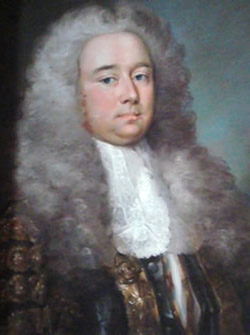
Judge Bowes (photo. Gerard Whelan)
It is said that Dr. ISAAC MANN actually resided for a number of years in the Lodge. This was presumably whilst he was Vicar of St Andrews Church and Archdeacon of Dublin. He was a very prolific writer of religious and secular texts whilst domiciled in Mount Merrion. In 1772 he was appointed Bishop of Cork where he died in 1788.
Jocelyn’s best friend in school was Philip Yorke the Earl of Hardwick who was a long serving Lord Chancellor in England. So it no surprise that Jocelyn befriended Philip’s cousin WILLIAM YORKE the Chief of Common pleas who himself became Lord Chancellor (1761—63). In 1744 William married the niece of HENRY SINGLETON the Drogheda born friend of Jocelyn. Singleton succeeded Jocelyn as Lord Chancellor, a notable feat for an Irish born Nobleman. He was usually in the company of another future Lord Chancellor LORD BOWES of CLONLYON, the Bishop of Ferns ROBERT DOWNES, the Lord Lieutenant LORD HARRINGTON and his successor WILLIAM CAVENDISH the DUKE OF DEVONSHIRE.
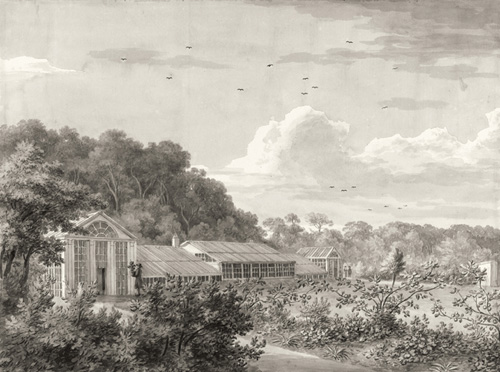
Jocelyn was continually adding little bits to the Demesne. Shortly after he arrived he sunk a well in what is now the Deerpark. He was in constant contact with Richard the 6th Viscount who is responsible for building addition to the original Lodge and for laying out the walkways and the plantation of Avenue trees in the Park. Richard the 6th moved back to Mount Merrion in 1756 and lived there till his death in 1776.
Between 1789 and 1793 the Lodge was rented out to its most notorious tenant “BLACK JACK” FITZGIBBON, LORD CLARE. Fitzgibbon was a very unpopular politician among his countrymen. Whilst in situ his most notable guest was the “Birthday Boy” the Prince of Wales who subsequently acceded to the throne as GEORGE IV.
Between 1802—1806 the Lodge was let to PETER La TOUCHE the MP for Leitrim. There are no records of any parties or guests during his tenure.
Pen Pictures of notable Tenants/Visitors/ Guests to Mount Merrion Lodge. These do not include Lord Chancellor Residents.
William King, Archbishop of Dublin (1650—1729) King was a friend and confident of Richard the 5th Viscount. It is rumoured that in his later years he did most of his writing in Mount Merrion. This very influential and interesting man was born in Antrim to staunch Scottish Presbyterian Settler parents. At an early age he converted to Anglicanism and became a bitter opponent to Presbyterianism. Ordained in 1674 he was Bishop of Derry before becoming Archbishop of Dublin in 1703. He was a prolific author of Books, Pamphlets and Papers, most of which are in TCD Library.
George Berkeley, Bishop of Cloyne (1685—1753). Kilkennyman Berkeley was one of the most accomplished and interesting men of his era. He was brilliant in many ways. He wrote excellent medical papers, he was a renowned mathematician, he lectured in Greek and Hebrew in TCD. He was particularly close to his former school friend from Kilkenny College, Thomas Prior. In some circles we was best regarded for his Philanthropic work which included setting up a Missionary College in Bermuda and as a Governor of the Foundling Hospital, caring for abandoned children in London. When in Dublin he was a frequent guest of Judge John Wainwright in Mount Merrion.
Robert Clayton, Bishop of Killala, Cork, Clogher (1695—1758) Obviously John Wainwright had a fascination for Clergymen as many of his guests were men of the cloth. Bishops, of course, were also permitted to sit in the House of Lords and it is there that many of them established their reputations. Dubliner Robert Clayton, for example, made a speech in the House that caused pandemonium. He called for the removal of the Nicene Creed from the Book of Common Prayer. This led to calls for his expulsion from the House of Lords, from the Bishopric and to threats of Trial for Heresy. Clayton’s City home was what is now Iveagh House on St Stephen’s Green. It is also interesting that contemporary Poet Paul Durkan featured Clayton in a 1990 poem called “Crazy about Women” Hmmm!
George Stone, Archbishop of Armagh (1708—1764) Londoner George Stone came to Ireland as Chaplin to the newly appointed Lord Lieutenant, Lionel Sackville the 1st Duke of Dorset in 1731. They both made their mark as Sackville had a few streets named after him and his Chaplin rose thru the ranks to become Archbishop of Armagh. But it was in the House where he became friendly with Robert Clayton and where he had numerous clashes with the Speaker Henry Boyle. Whilst he strongly defended England’s right to be in Ireland he was tireless advocate of Catholic rights. He appears to have been a more committed Politician than Clergyman.
Lionel Sackville, Lord Lieutenant (1688—1765) Sackville appears to have been a quiet and understated man. Yet he gained more recognition than many of his predecessors or successors. He twice served as Lord Lieutenant in Ireland 1730/1737 and 1751/1755. It was during his first term that he became very friendly with John Wainwright. In fact He, his Chaplin and his then colourful Secretary, Budd Dodington were frequent dinner guests and visitors to Mount Merrion.
George Budd Dodington, Sec to Lionel Sackville (1691-- 1762)
In today’s parlance Dodington would be termed as a “Chancer”. Born George Budd he inherited a vast estate from his uncle and proceeds to adapt his uncle’s name, Dodington. He got elected MP for Winchelsea and so began a life of manipulation, vote rigging, duplicity, Coat turning and all kinds of chicanery. But he was rewarded with a Barony by a grateful Monarch or Prime Minister, Baron of Melcombe and Regis. He only gets a mention because he was friendly in his early years with John Wainwright and visited with him in Mount Merrion.
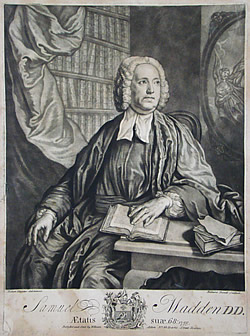
Samuel Madden, Author& Clergyman (1686—1765)
(photo. Gerard Whelan)
Dr. Samuel Johnson wrote of this son of Dublin “His is a name that Ireland aught to honour” A TCD Graduate he cofounded with Thomas Prior and others the Society that would later be called the Royal Dublin Society. Among his many achievements he is credited with writing the World’s first Science Fiction novel called “Memoirs of the Twentieth Century”. It was regarded as being so radical that Prime Minister Sir Robert Walpole ordered its withdrawal. The first banned novel perhaps. No doubt that would have appealed greatly to Robert Jocelyn whose Sunday Lunch gathering he attended as a regular visitor.
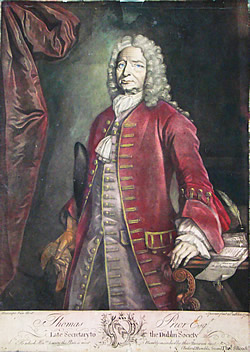
Thomas Prior
(photo. Gerard Whelan)
Thomas Prior, Farmer and Author (1681—1751) A Rathdowney man who was also educated in both Kilkenny College and TCD. Probably because he came from Farming stock he dedicated his life to improving the quality of Farming and Agriculture in Ireland. Apart from his own research and writings he studied methods from other countries and adapted them for use here. Prior was a great supporter of his old school friend George Berkeley. In 1731 he and a group of like minded colleagues founded the Dublin Society which later changed its name to Royal Dublin Society (RDS). Among his most notable books were “The Absentees in Ireland” which upset a number of that very group resident in England and a Berkeley inspired work “The virtues of Tar Water”. Prior was a regular visitor to Jocelyn’s Sunday gathering.
John Lodge, Genealogist, Archivist and Author (1701—1774) Another regular at the Sunday gatherings was this Farmer’s son from Lancashire. He came to Ireland as Deputy Keeper of the Rolls and Registrar of the Court. Not only was he a brilliant archivist but he wrote what is still considered to be one of the most important social histories of Ireland “The Peerage of Ireland” in 1754. Scholars still refer to it as being” beyond value”. Judging from his choice of guests it is evident that Lord Chancellor Jocelyn preferred the company of Artisans and Artists to that of Politicians and Clergy.
Walter Harris, Historian and Artist (1686—1761) Harris, a native of Mountmellick was another former Kilkenny College and TCD graduate to find comfort and solace in the beautiful ambiance of Mount Merrion. It was Mount Merrion that He and his friend Charles Smith first thought of their grand venture. It is reported that it was here that he first broached the idea of editing the vast documentary collection of works by his forebear Sir James Ware...
Charles Smith, Medical Doctor and Historian (1715—1762) Despite being a Medical Doctor this Dungarvan man was a Historian at heart. And not just any historian. He and his friend Walter Harris decided to compile comprehensive histories of every county in Ireland. They started well and within a few years had produced good informative Histories of Counties DOWN, WATERFORD and CORK. After that the travel got too much for Harris and he withdrew from the project. Smith went on to produce his most important tome “The History of County KERRY” in 1756. All their books contain beautiful Illustrations and engravings. Many are preserved in the museum in Waterford.
ROBERT DOWNES, Bishop of Down and Conor (1704—1763) The one Clergyman listed as being a regular at the Sunday gathering was Robert Downes, when he was Bishop of Ferns. There is very little written about him except that he was the son of a rather extroverted Bishop of Derry. Maybe that is why he kept a low profile. It is also possible that he did not sit in the House of Lords and therefore had a low profile.
William Stanhope, Lord Harrington, Lord Lieutenant (1690—1756)The First Earl Harrington and Lord Petersham had a chequered history in England depending who was in power. He was either an integral part of the Powerbase or was dumped only to be resurrected. Ambassador to Spain, State Secretary and towards the end of his career Lord Lieutenant in Ireland 1747—1751. His descendents are still based in County Limerick.
